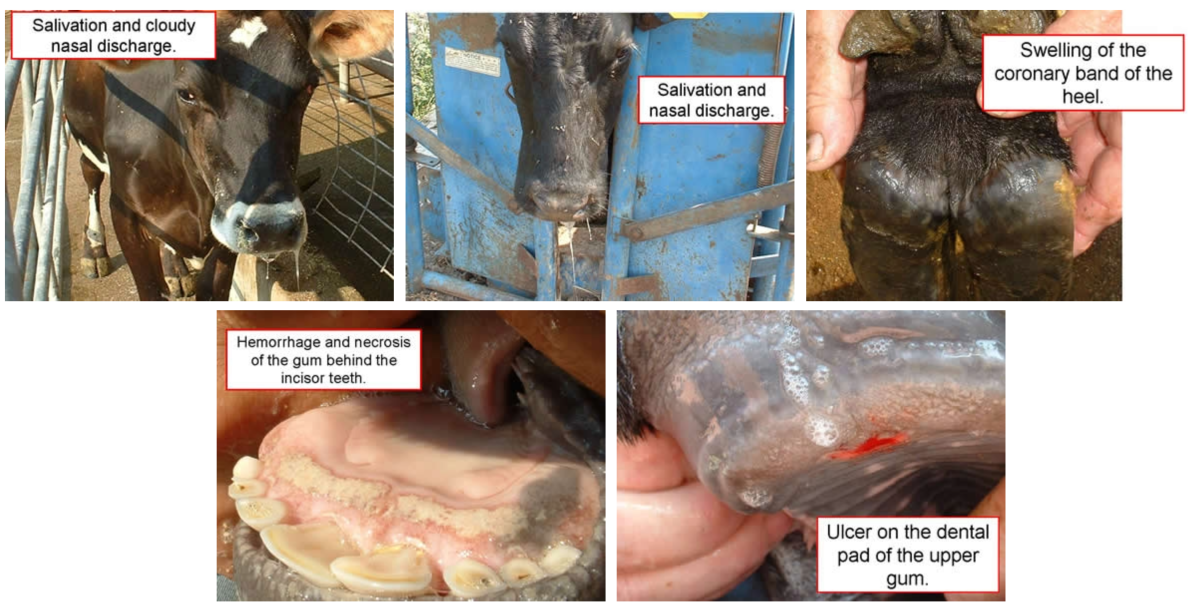Epizootic Hemorrhagic Disease (EHD)
Epizootic Hemorrhagic Disease (EHD) is caused by the Epizootic Hemorrhagic Disease Virus (EHDV) and can impact cattle, creating considerable economic losses due to decreased productivity. Symptoms include:
-
Salivation and cloudy nasal discharge
- Swelling of the coronary band of the heel
- Hemorrhage and necrosis of the gum behind incisor teeth
- Ulcer on the dental pad of the upper gum
Ohio Department of Agriculture
Animal Disease Diagnostic Lab
During lambing, kidding, and calving seasons, common questions about abortions, calf scours, and other issues arise. Here are some general guidelines for obtaining help with disease diagnosis.
First, obtaining at least a tentative diagnosis is crucial for formulating effective and cost-efficient treatment, control, or prevention plans. This process should start with a local veterinarian, who can offer diagnostic services such as bacterial culturing, blood work, and post-mortem examinations. If additional testing is needed, the veterinarian may send collected samples to a laboratory. For valuable live animals, a full diagnostic effort might involve sending the animal to a referral center like the Ohio State's College of Veterinary Medicine’s large animal hospital, especially in cases involving multiple animals.
Occasionally, a veterinarian may recommend that an animal owner deliver a dead animal or other samples to a diagnostic laboratory, such as the ODA’s Animal Disease Diagnostic Laboratory. This full-service laboratory, accredited by the American Association of Veterinary Laboratory Diagnosticians, performs post-mortem examinations and collects samples for further testing. They also provide diagnostic tests for other samples, such as placentas from abortion cases or tissue samples for trace mineral analysis (copper, selenium, lead, etc.).
When delivering animals or samples to the Animal Disease Diagnostic Laboratory, owners must provide information about the problem and any pertinent observations. Often, the veterinarian will call ahead to inform the laboratory about the incoming samples. If not, the owner will be asked for their veterinarian's name. Results of post-mortem examinations and diagnostic tests, along with service charges, are sent to the veterinarian. Typically, the laboratory sends a preliminary report of post-mortem findings the next workday, followed by test results within a few days. In some cases, initial findings are available almost immediately. With the laboratory's current computer system, veterinarians can access lab results and updates 24/7. A final report is sent to the veterinarian once all results are available, and the veterinarian shares these medical records with the animal owner.
In urgent cases, a large animal may need to be submitted to the laboratory on a weekend to preserve it under refrigeration until a post-mortem examination can be performed. Regular necropsy and diagnostic services are not available on weekends, but arrangements can be made by calling ahead at 1-614-728-6220. After normal work hours (8 AM – 5 PM Monday through Friday), an after-hours emergency phone number is provided. In some cases, the veterinarian can perform the post-mortem examination in the field, keep fresh samples refrigerated over the weekend, and ship them overnight to the lab on the next workday.
Accurate diagnosis is essential for effective treatment and control efforts, which can be costly and ineffective without it, potentially compromising animal welfare. In today’s economic climate, using the best information available is crucial.

